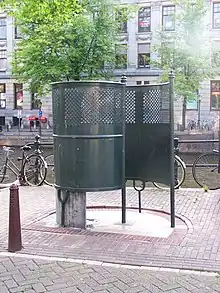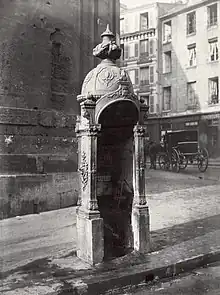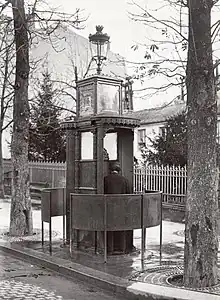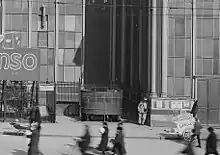Pee curl





The pee curl (Dutch: plaskrul) is a public urinal, many of which are found in the centre of Amsterdam. They originated at the end of the 19th century, and were first installed by the Public Works Department of Amsterdam.
The curl is made of a spiral-shaped steel sheet suspended half a metre above the ground by four iron legs, and painted dark green. The top half of the plate is perforated so that any passers-by can determine at eye-level whether it is vacant or in use. The floor is made of tiles with a natural stone slab making up the urinal itself, housing the central drain. The curls are connected to the sewer by this drain and are cleaned by the local municipality with water from the canal. The curls come in either a single or double version, with some coming equipped with roofs.[1]
History
By the 1800s, public sanitation in Paris was in a shambolic condition, the city being plagued by public urination. The population was also rapidly rising with an expectation for it to pass a million by 1840, meaning the problem could only get worse.[2]
In the spring of 1830, the city government of Paris decided to install the first public urinals on the major boulevards, with them being ready come the summer. In July that same year however, many were destroyed and used as street barricades during the French Revolution of 1830.[3]
In 1832, a cholera epidemic spread from Britain to Paris, killing 18,500 people (or roughly 2% of the city's population at the time) in 169 days. Among the dead was the French Prime Minister Casimir Pierre Périer. The epidemic also brought Paris' economy to a standstill, with anyone who could flee doing so and anyone who stayed adopting futile measures to protect themselves from it.[2][4]
In 1839 the Préfet de la Seine Claude-Philibert de Rambuteau began installing over 400 pissoirs in an effort to fix the sanitation issues that plagued Paris while also working to improve the water supply to the city, to enlarge the Paris sewer system and to install gas lighting in the city. The pissoirs that were installed at the time were simple, single-person masonry tubes with an entrance cut into the street side and a cornice and ball above. Despite these efforts, Parisians still relieved themselves "en plein air" according to an April 1843 column in the Gazette Municipale.[3][5]
In 1859, 20 years after the introduction of the pissoirs, Dutch inventor Leijs proposed the placement of similar hollow pillars to try and solve Amsterdam's issues with public sanitation, however the design of the pee curl was chosen. In the 19th and most of the 20th century facilities like the Dutch pee curls and French pissoirs were used by homosexual men to have sexual intercourse. The anxiety of the public and indeed the government about homosexuality is clearly visible in the design of the pee curl and later designs of the pissoir.[2][5]
The first of these pee curls weren't installed until 1870, with 1877 bringing the first double pee curl - an S shaped curl with opposing chambers - to the Paleis voor Volksvlijt. An updated design of the pee curl was later created in 1916 by architect Joan van der Mey.
19th century and women's rights
Amsterdam has had a urinary committee since 1928. Despite the Second World War, meetings continued under the so-called "Committee of Consultation on the Urinal Question in Amsterdam". In 1941, a new urinal committee was established. Throughout the entire history of the committee, the ratio of male to female public toilets has always been heavily skewed, with the committee initially being of the opinion that public toilets were intended "for the man who has his work on the street". Another rationale for the gender disparity of public toilets being heavily skewed is that "Public toilet facilities, especially those for women, involved very high costs."
At the same time, there were fears (as stated previously) that enclosed public toilets would result in a higher rate of public indecency, where two person urinals "often acted as places for gay men to meet and engage in sexual acts."
In December of 1969, a Dutch Feminist group called Dolle Mina was founded to campaign for equal rights for women, including public "pee-right". The group mainly fought to improve said rights by using protests in a playful and humorous manner.[6] One of these protests occurred in Amsterdam's Dam Square in April 1970, installing a "towering papier-mâché penis with a sign that read ‘damestoilet’ (ladies’ room)." The structure was placed there to address the lack of public toilets for women in Amsterdam.[7] Also in 1970, several public toilets were wrapped with pink ribbons to protest this imbalance.[8]
In 1984 the Urinal Commission published a report recommending the installation of the Sanisette, a lockable and self-cleaning unisex public toilet which was pioneered by the French company JCDecaux. Negotiations were in an "advanced stage", however the plans were cancelled in 1985 due to a lack of funds.
Plasrecht
In 2015, Geerte Piening was fined €90 for public urination when she relieved herself in an alleyway in Amsterdam due to the fact that the nearest public toilet that was designed for use by women was several kilometres away. She refused to pay the fine on the grounds that she felt that the design of public toilets in Amsterdam discriminated against women, and she was unable to go to a bar to pay to go to relieve herself as it was beyond closing time.
The male judge in the case, however, held that “It would not be pleasant but it can be done,” in regards to the use of urinals and pee curls and she was forced to pay the fine.[9] This led to widespread mockery by the public and even led some women to demonstrate the "obvious difficulties" of using male urinals.[10]
This event also led to a call being put out on Facebook by Cathelijne Hornstra for people to gather and protest at the spot where Geerte was found by Police. The protest was cancelled because of the overwhelming interest, with the organisers asking those interested (said to be nearly 10,000 women) to gather at urinals across Amsterdam. Attendees were asked to upload photos on Facebook and Instagram with the hashtag "#wildplassen", the Dutch word for the crime of public urination.[11]
21st century use
In 2008 all remaining examples of the original pee curls were repainted, galvanised and restored.[2][12] The city had thirty-five of the original pee curls as of 2017,[13] of which two were the curls designed by Joan van der Mey. Amsterdam also has many different kinds of other public urinals, with portable urinals being used for outdoor concerts and other events, retractable urinals being able to be used overnight before retracting into the ground and wheelchair accessible urinals for those who need them.
In 2016, it was announced that new retractable urinals for women would be placed in Dam Square, Amsterdam. The urinals were equipped with two urinals for men and one for women, with the one for women having a lockable sliding door.[14] Unfortunately, there is still limited public toilet availability for women, with only a few throughout the city being accessible.
The pee curls to the side of the canals are kept in place by the local government to keep people from publicly urinating and thereby falling in the canal in an attempt to cut down on the amount of people falling into the canal; an average of 15 people drown each year in the canals due to multiple causes, including public urination.[15]
 A pee curl with graffiti
A pee curl with graffiti_met_krul.jpg.webp) A pee curl next to a canal
A pee curl next to a canal A pee curl depicted in the Sexmuseum Amsterdam
A pee curl depicted in the Sexmuseum Amsterdam
References
- ↑ iBecomingDutch (2020-08-30). "KRUL". I Becoming Dutch. Retrieved 2023-08-28.
- 1 2 3 4 "Pissoirs — Public Urinals with Little to No Privacy". Toilets of the World. Retrieved 2023-08-28.
- 1 2 "Pissoir", Wikipedia, 2023-06-13, retrieved 2023-08-28
- ↑ "Pandemic Lessons From the Era of 'Les Miserables'". Bloomberg.com. 2021-04-27. Retrieved 2023-08-28.
- 1 2 blindfieldcollective (2017-04-20). "Patenting The Pissoir: Queer Bodies and Proprietary Technologies". Retrieved 2023-08-28.
- ↑ Nota, Justine Donia (7 July 2021). "(REST)ROOM FOR IMPROVEMENT" (PDF). Retrieved 28 August 2023.
- ↑ "The Protestor's Playground | History Today". www.historytoday.com. Retrieved 2023-08-28.
- ↑ "Sandberg Instituut". www.sandberg.nl. Retrieved 2023-08-28.
- ↑ Wolthuizen, Josien (2017-09-18). "Toch wildplasboete: 'Vrouwen kunnen ook in urinoir plassen'". Het Parool (in Dutch). Retrieved 2022-09-25.
- ↑ "Dutch sexism outcry after woman fined for peeing in public". Yahoo News. 2017-09-20. Retrieved 2023-08-28.
- ↑ Boffey, Daniel (2017-09-21). "Protests planned at Amsterdam urinals over lack of women's toilets". The Guardian. ISSN 0261-3077. Retrieved 2023-08-28.
- ↑ De krullen van Amsterdam, D. Cornelissen & Zonen, 2008
- ↑ "Urinoirs Stadsdeel Centrum - Datasets - Kaart van Amsterdam - Gemeente Amsterdam". Gemeente Amsterdam (in Dutch). 2018-03-04. Archived from the original on 2018-03-04. Retrieved 2022-09-25.
- ↑ "World's first: Retractable hidden urinal for women set for Amsterdam's Dam Sq. | NL Times". nltimes.nl. Retrieved 2023-08-28.
- ↑ Te veel mensen verdrinken in de Amsterdamse grachten, NRC, 25 March 2017